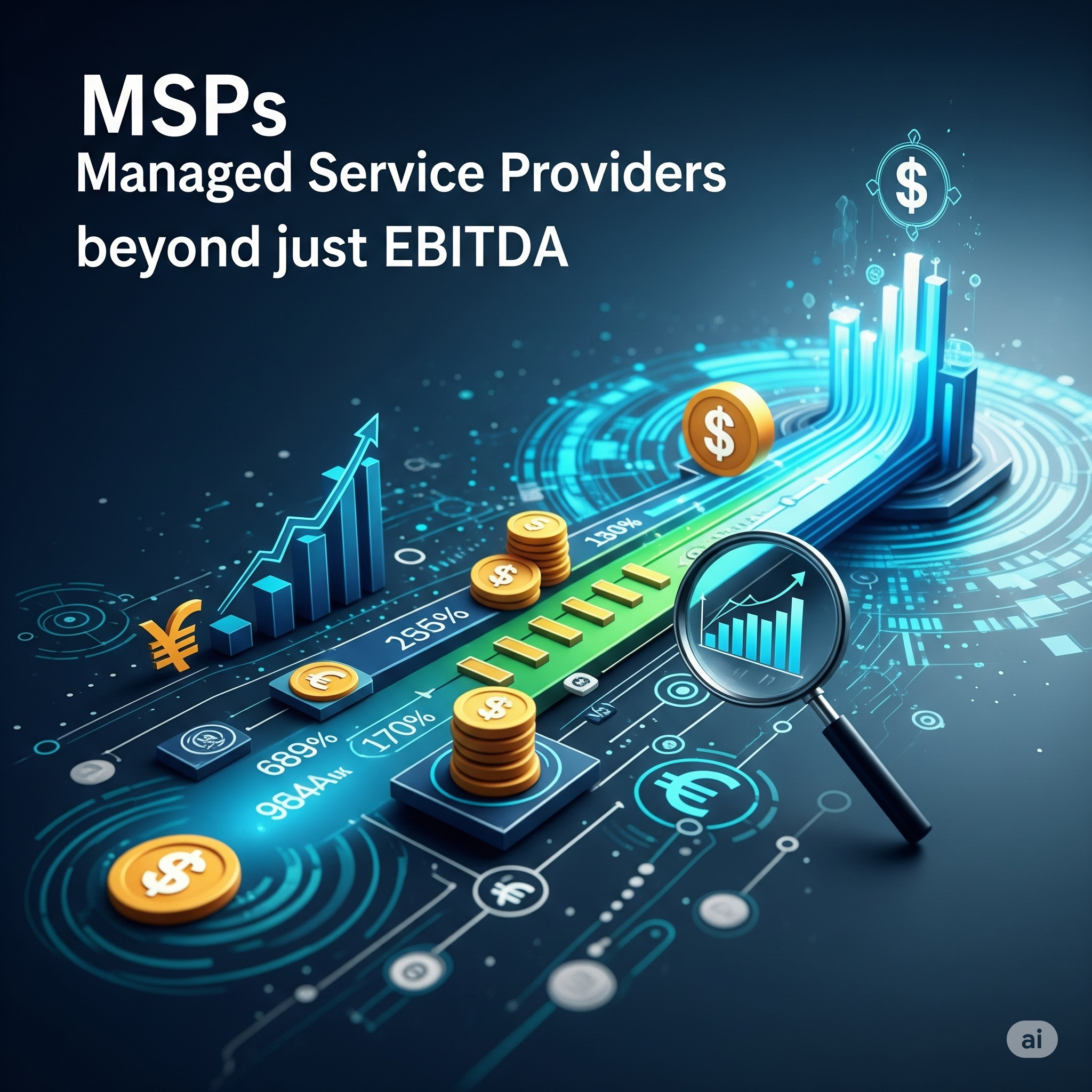When it comes to selling or attracting investment for your MSP, everyone talks about EBITDA. Indeed, buyers often value MSPs as a multiple of EBITDA. But focusing only on EBITDA would be a disservice to yourself and your business. Investors will dig deeper into financial metrics to understand the quality, stability, and growth potential of your business. In this post, we’ll explore key financial metrics beyond EBITDA that play a pivotal role in determining your MSP’s value. These include Gross Margin, Recurring Revenue Mix, Customer Retention Rate, Revenue per Employee, Net Revenue Retention, and Cash Flow from Operations.
Whether you’re planning for an acquisition or just want to maximize your company’s worth, understanding these metrics will help you see your business the way a buyer or investor does. Let’s break down why each metric matters in the MSP world and how it can impact your valuation.
Gross Margin: Efficiency in Service Delivery
Gross Margin represents the percentage of revenue left after accounting for the direct product and direct labor costs of delivering your services (cost of goods sold). In plain terms, it measures how efficiently you provide your IT services. A higher gross margin means you’re keeping more of each dollar of revenue as profit after service delivery costs – a strong indicator of operational health. In fact, gross margin is one of the most telling metrics for an MSP’s efficiency: the more you can raise it, the more room you have to reinvest in growth, hire staff, or buffer unexpected costs.
Real-world data suggests that average MSPs tend to have gross profit margins around 50–60%, while best-in-class MSPs aim for 70% or higher. If your gross margins are much lower, it often signals inefficiencies or an unfavorable revenue mix. For example, heavy resale of low-margin hardware or under-utilization of technicians will drag down gross margin. Acquirers know this, and they prefer revenue that comes from high-margin services rather than low-margin product sales. One industry study noted a clear preference for service revenue with gross margins above 50%, versus hardware resale that might only carry ~20% margins. The takeaway: strong gross margins translate to a well-run operation, and buyers will pay more for an MSP that can deliver services efficiently. If your margins are lagging, consider steps to improve pricing, reduce direct costs, or optimize staff utilization – it will not only boost your profitability but also make your business more attractive to potential buyers.
Recurring Revenue Mix: The Power of Predictable Income
Not all revenue is created equal. Recurring revenue – the income you earn from ongoing service contracts, managed services agreements, and subscriptions – is far more valuable than one-time project fees. Investors and acquirers love recurring revenue because it provides predictable, steady income and lowers their risk. In other words, an MSP built on long-term contracts and ongoing monthly fees offers a “purest form of predictability” in revenue, which buyers reward with higher valuations. Some buyers even require a minimum percentage of revenue to be recurring before they’ll seriously consider an acquisition. A common benchmark is at least ~50% of revenue from contracted recurring services. Below that, many MSPs struggle to garner interest from investors. By contrast, top-tier MSPs often generate 75–80% or more of their revenue from recurring sources.
The logic is simple: the more of your revenue that is locked-in and predictable, the more confident a buyer can be about your future cash flows. Recurring managed services revenue, in particular, commands the highest value (even more so than recurring hardware/software resale). In practice, emphasizing recurring revenue can mean shifting your business model towards managed service contracts, IT support plans, cloud subscriptions, or retainer agreements rather than one-off projects. If you’re currently below the desired mix, think about how to convert more clients to long-term agreements or bundle services into ongoing packages. A higher recurring revenue mix can directly boost your MSP’s valuation, as buyers will pay a premium for the stability and forecastability it provides.
Customer Retention Rate: The Value of Loyalty
While winning new customers is great, keeping them is even more important – especially in the eyes of an acquirer. Customer Retention Rate measures the percentage of customers your MSP retains over a given period (usually yearly), excluding new customer adds. High retention means low churn, and it’s a strong sign that your clients are satisfied with your service (and that your recurring revenue is secure). Most investors in the MSP space look for annual customer retention around 90% or higher. If you’re losing more than 1 out of 10 clients per year, that high churn will be a red flag that could lower your valuation. Buyers will typically scrutinize your retention trends over several years to see if they’re improving, stable, or declining. A steadily high retention rate tells a story of loyal clients and reliable revenue, whereas a falling retention rate (rising churn) signals potential issues in service quality or competitive pressure.
Why does this metric matter so much? Beyond the direct revenue impact, retention is tied to profitability and growth. It’s well known that it costs far less to keep and grow an existing customer than to acquire a new one. One study found that increasing an MSP’s customer retention by just 5% can lead to profit increases of 25% to 95%. Higher retention allows an acquirer to bank on recurring revenues and possibly even expand them (more on that in the next section). On the flip side, high churn means a buyer might have to invest heavily in sales just to maintain revenue levels, which usually results in a lower offer. Bottom line: focus on keeping your customers happy – provide excellent service, maintain regular communication, and find ways to continually demonstrate value. Strong customer retention not only boosts your current profits, it directly increases your MSP’s appeal (and price) to buyers who value a loyal customer base.
Revenue per Employee: Productivity and Scalability
Another metric that often flies under the radar is Revenue per Employee. This is a simple calculation: your total revenue divided by the number of full-time-equivalent employees (including yourself as the owner-operator, if applicable). In essence, it gauges how efficiently your MSP turns its human resources into revenue. Because labor is typically the biggest expense for an IT service business, this metric reveals a lot about your operational productivity. A higher revenue-per-employee figure suggests that your team is lean and effective – either through automation, strong processes, higher pricing, or all of the above. A lower figure might indicate inefficiencies, overstaffing, or underpricing of services.
So what does “good” look like here? It varies by company size, but industry benchmarks do exist. For example, an MSP with just a handful of employees (say 4–7 people) might average roughly $125,000 in revenue per employee. As MSPs grow and optimize, that number tends to rise. Many larger MSPs (8+ employees) operate in the $150,000 revenue per employee range, and high-performing firms can exceed $200,000 per employee annually. For a buyer, a high revenue-per-employee ratio signals that your MSP could scale up without a proportional increase in headcount (hence lower incremental costs). It often correlates with better profit margins and management talent in the company.
If your revenue per employee is on the low side compared to peers, don’t panic – instead, use it as an insight. You may need to streamline workflows, invest in tools that automate routine tasks, train your team to handle more clients, or re-examine your pricing strategy. Improving this metric not only boosts your bottom line in the near term, but also paints a picture of a well-run, scalable operation for any future acquirer. In short, productivity pays. Buyers will take note of an MSP that can generate more revenue with a given team size, because it suggests a strong foundation for growth (and fewer headaches integrating the business post-sale).
Net Revenue Retention: Growth Within Your Customer Base
Closely related to customer retention is Net Revenue Retention (NRR) – a metric often borrowed from the SaaS world that’s highly relevant to MSPs with recurring revenue. While customer retention (sometimes called “logo retention”) tracks whether you kept the customer account, NRR measures how much of the revenue from your existing customers you retained (and ideally grew) year-over-year. This calculation takes your starting recurring revenue from clients, subtracts any revenue lost from churn or downsells, and adds any expansion revenue from upsells or price increases. The result is expressed as a percentage of the starting revenue. An NRR above 100% means your existing customer base is generating more revenue this year than last – indicating that expansions and price increases outweighed any losses. This scenario is often termed “negative churn” (a great thing to have!).
For MSPs, net revenue retention is a powerful indicator of account growth and customer success. Buyers pay close attention to it because it encapsulates several aspects of business health: your customer loyalty, your ability to upsell services, and the headroom you have with your clients. An MSP could have, say, 90% customer retention (losing a few clients), but if it successfully expanded services with many of the remaining clients, it might still achieve 100%+ NRR. Top-performing MSPs often hit net revenue retention numbers in the high 90s or above 100%. In fact, some of the best MSPs boast over 100% recurring revenue retention, meaning their existing clients collectively spend more every year. Industry benchmarks suggest that maintaining NRR in the 95%+ range is solid for an MSP, with anything over 100% being world-class. Investors generally consider NRR even more significant than raw customer count retention, because it’s revenue-weighted. Losing a small client with minimal revenue won’t hurt NRR much, but losing (or shrinking) a large client contract will – and that’s exactly the risk buyers want to evaluate.
To improve NRR, focus on growing the value of your existing customer relationships. This can mean introducing new services (security offerings, cloud solutions, vCIO consulting, etc.) to increase each client’s spend, or implementing regular (annual) price reviews for contracts. Many MSPs that achieve 100%+ NRR cite strategies like annual price increases and cross-selling as key drivers. The practical implication: if you can demonstrate to a buyer that your customer base doesn’t just stick around but actually spends more with you over time, you’ve made a compelling case that your business will naturally expand revenues without aggressive new sales efforts. High NRR is a green flag that indicates strong account management and a value proposition that grows along with your clients’ needs. It can meaningfully elevate your valuation multiple, as it assures the acquirer of built-in growth after the deal.
Cash Flow from Operations: Show Me the Cash
Lastly, behind all the earnings metrics lies the ultimate reality check – Cash Flow from Operations (CFO). This metric, found on your cash flow statement, tells how much actual cash your business is generating from its core operations after paying suppliers, employees, and other operating expenses. In other words, it’s the true cash earnings of your MSP, stripping away any accounting nuances. A strong, positive operating cash flow gives buyers confidence that your EBITDA is backed by real cash that can service debt, fund growth, or be returned as profit. Conversely, if your EBITDA is high but your operating cash flow is consistently low or negative, it’s a warning sign. It might indicate issues like slow collections (accounts receivable problems), high working capital needs, or heavy capital expenditures that eat up cash.
The good news for MSPs is that, in many cases, they are not very capital-intensive businesses. You’re typically not building factories or carrying huge inventories, so there’s often a close alignment between accounting profit and cash flow. In fact, for most MSPs, EBITDA is a reasonable approximation of pre-tax operating cash flow. However, there are exceptions. If your MSP engages in capital-heavy projects – for example, running a private cloud infrastructure or leasing a lot of hardware to clients – then depreciation and equipment purchases become significant. In those scenarios, an investor will look beyond EBITDA and consider EBITDA minus capital expenditures to gauge true cash generation. Similarly, if you bill clients in arrears or allow long payment terms, you could be profitable on paper but struggling on cash due to working capital being tied up.
Why does operating cash flow matter in valuation? Because it speaks to the quality of your earnings. Buyers ultimately care about cash return on their investment. A company that shows $1 million EBITDA but only $100k in operating cash flow (due to, say, massive working capital requirements or uncollected bills) will not get the same multiple as one that converts most of its profit into cash. Lenders and investors often scrutinize cash flow to ensure the business can fund its day-to-day operations and any acquisition-related debt without financial strain. In practical deal terms, operating cash flow also ties into working capital negotiations – buyers expect a seller to leave enough working capital (like accounts receivable and inventory minus payables) in the business to maintain its cash flow post-sale. If your cash flow is weak or volatile, a buyer might reduce their offer or demand more onerous terms to mitigate the risk.
To maximize your MSP’s value, pay attention to cash flow management. Ensure you’re invoicing promptly, collecting payments on time, and managing expenses carefully. If you have projects that require upfront costs, try to structure client payments to match those outflows (e.g. deposit payments or progress billing). The goal is to demonstrate a smooth and healthy cash generation machine. When your financial statements show that revenues translate into real cash in the bank, you remove a lot of doubt for a potential buyer. Strong operating cash flow validates your EBITDA and can support a higher valuation, whereas any inconsistencies will invite questions during due diligence. In short: show them the money!
Final Thoughts
EBITDA will always be a central figure in MSP valuations, but it’s far from the only one. The metrics beyond EBITDA – gross margin, recurring revenue mix, retention rates, revenue per employee, net revenue retention, and operating cash flow – each capture a crucial dimension of your business’s strength. Together, they paint a comprehensive picture of your MSP’s performance and potential. As an owner, you should not only track these metrics, but also take steps to improve them well before you enter an M&A process. High gross margins and efficient operations drive profitability; a rich stream of recurring revenue and loyal customers drive stability; growth within your customer base drives future upside; and solid cash flow seals the deal by proving your earnings are rock-solid.




